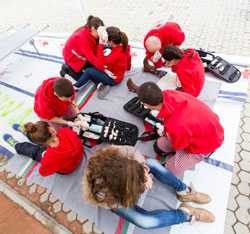Be Ready, Be Healthy
 Start talking to those around you about emergency preparedness today.
Start talking to those around you about emergency preparedness today.
September is National Preparedness Month, a great time to think about how prepared you are for an emergency. Disasters impact every part of the community so have emergency plans not only for your family, but also for your neighborhood, workplace, school, and global community. Here are some tips on how you can prepare for everywhere and be ready no matter where you are when an emergency occurs.
Be Ready, Be Healthy
Healthy families and healthy communities are better prepared to respond to and recover from emergencies. Practicing healthy habits before an emergency occurs will help you and your family avoid illness and injury when they are faced with a disaster. Teaching your family healthy habits like proper handwashing and good hygiene can help reduce the spread of disease during emergencies.
Communities also can take steps to be healthy and ensure that they are more resilient and prepared to recover after a disaster. Communities with high vaccination rates, easily accessible healthcare, available mental health resources, and programs that encourage healthy behaviors often recover from disasters quicker and with less negative health problems.
You can help make your family and community healthier and more resilient by taking simple steps to improve your health and the health of those around you.

A healthy, prepared community is stronger and better able to withstand and respond to emergencies.

In an emergency, neighbors are usually the first on the scene, providing critical help until first responders can arrive. Help your community and get trained in first aid!
The First Responder in You
The first people to offer aid during an emergency are typically the people who are closest to the situation. When faced with a disaster, you may be one of the first on the scene to provide aid to others, or you may have to rely on the people around you for help. Take action now to be prepared to help in an emergency. Whether it is taking a first aid or CPR training or volunteering with a local emergency preparedness group, know how you can help during a disaster.
Don’t Wait, Communicate!
According to FEMA National Personal Preparedness Survey, 53% of Americans receive preparedness information by talking with neighbors, friends, or, family. Are you one of them? Start talking to those around you about emergency preparedness today. Meet your neighbors, and talk about who will need and how you can provide aid during an emergency. Don’t wait for an event to occur to introduce yourself.
When a disaster strikes, people are forced to communicate due to necessity. To build a stronger, more connected community, start reaching out and making those connections now. Start small. Meet your neighbors. Get involved in your community. Build that connection. You never know when you might need a helping hand or when you may find yourself in the role of a first responder.
Visit CDC’s National Preparedness Month site.
More Information
- Page last reviewed: September 8, 2015
- Page last updated: September 8, 2015
- Content source:
- CDC Emergency Risk Communication Branch (ERCB), Division of Emergency Operations (DEO), Office of Public Health Preparedness and Response
- Page maintained by: Office of the Associate Director for Communication, Digital Media Branch, Division of Public Affairs




 ShareCompartir
ShareCompartir